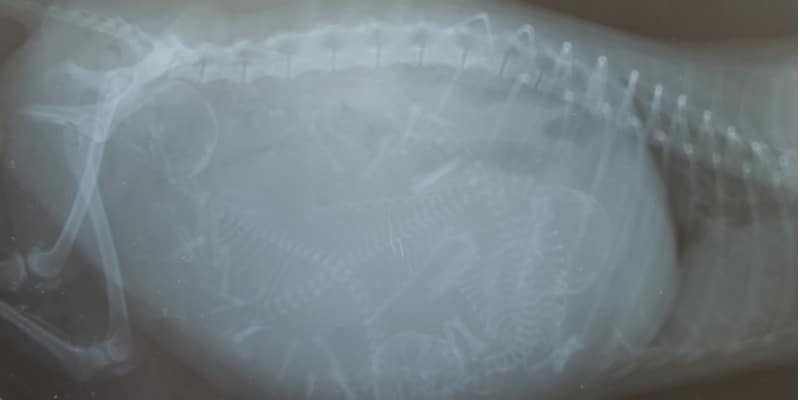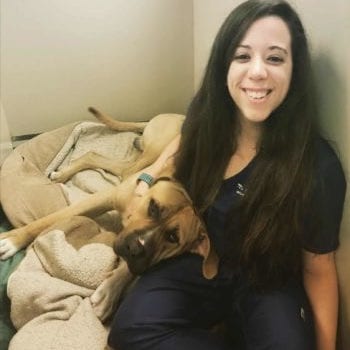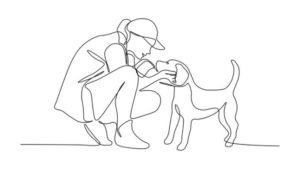Your dog is pregnant, now what? Pregnancy can be an exciting time for a loved one, our furry friends included. With a litter of puppies quickly on the way, knowing the signs of pregnancy and what to expect during dog gestation will prepare you for what's ahead. Because pregnant dogs, also referred to as dams, are entirely self-sufficient while pregnant, it is essential to know what to expect and when to expect it!
With your dogs' health and safety in mind, a Canine Pregnancy Calendar will help keep your beloved pets' pregnancy on track. With the average dog gestation lasting approximately 63 days, or roughly two months, you will need to begin to prepare for a successful delivery. With your dogs' due date quickly approaching, understanding their pregnancy timeline will give you peace of mind while preparing for all of the beautiful things ahead.

In the first week of the gestation period, the fertilized egg is implanted into your dogs' uterus. The process generally takes 2-3 days as the egg travels from the ovaries, through the fallopian tubes, and into the uterus. During this stage of your dogs' pregnancy, you will not notice a difference in their behavior and appearance if your pet is healthy. Continue to feed and play with your dog as you normally would. No change to their diet is needed at this time.
The embryo's in the uterus will not have grown enough to warrant increasing the dam's caloric intake. At this point in the pregnancy, your dogs' weight should stay the same until the end of the fifth week. Continue to feed and play with your dog as you normally would. The nipples will begin to darken and become engorged around 14-15 days, but your pets' activity levels should remain unphased.
It is also important to begin to reduce stress in your dogs' life during pregnancy.
With this in mind, it is now time to start planning their first vet visit while pregnant.
The placenta begins to envelop the puppies in a covering membrane for protection and implants in the wall of the uterus during this week.
Begin increasing your pets' food intake as they will have a larger appetite as the puppies begin absorbing their nutrients. Any physical changes will be slight or unnoticeable. The fur on the abdomen will start to thin in preparation for nursing the puppies. Your dogs' activity levels and attitude should be stable and normal throughout this week.

If you haven't brought your dog to the Vet yet, this is the latest you'll want to take your dam in for their first pregnancy visit. On the 25th day, your Vet can perform an ultrasound to determine how many puppies you will expect at the time of birth. This exam is a crucial visit as your Vet will evaluate your dog for abnormalities at this point during her pregnancy. Though rare, your Vet may also discuss the likelihood of your pet needing a c-section to assist in the birthing process.
Your Vet should provide you with your dogs' new recommended caloric intake in preparation for Week Five. This may include switching them to a new high-calorie food, such as a puppy formula rich in essential protein and fat-rich nutrients, to meet their expected dietary changes. To ensure the transition goes smoothly, mix your dog's old food with their new diet so they do not develop a gastrointestinal illness or pancreatitis. A vitamin supplement should be added to their daily feeding regimen at the recommendation of your Vet. Have food readily available for your dog throughout the day.
By this time, your dog may experience periods of excitability. Sniffing, digging, pacing, and self-grooming are noted during this week. Consider assembling a quiet nesting area for your dam to retreat to as needed to alleviate these symptoms. Your dog's den may include plush blankets or newspapers in a kiddie pool or a small room such as a closet. The area needs to be large enough so that your dam can move and stretch about without fear of injuring her puppies.
Your dog will start to gain weight at this stage of her pregnancy. The puppies will begin forming their distinctive organs and finish embryogenesis. Your dogs' nipples will continue to swell at this point during the pregnancy, and the puppies will start increasing in size. They will begin to develop their whiskers, claws, toes, and even their reproductive organs!
If you haven't already, you will now need to begin feeding your dog more than their usual amount of food to keep up with their increased metabolic needs.
As the puppies continue to grow, their skin pigments will begin to develop. Prepare to bring your dog back to the Vet next week around day 45-47 to do another pregnancy check. Your Vet will ensure that you're feeding your dog enough food, your dam's weight is stable, and the puppies are growing as anticipated. Your Vet will continue to monitor your pet to determine if a c-section may be needed for the birthing process.
A dam may begin to lose her appetite due to the pain and discomfort from her enlarged uterus. During this time, it is important to encourage her to continue eating her high-calorie food and any recommended supplements by your Vet as the puppies will absorb a significant amount of your dogs' nutritional intake.
It is strongly encouraged to have food available for your pregnant dog at all times. To promote your dogs' appetite, consider supplementing her food with yogurt, lean meats, broth, cottage cheese, and various vegetables.
During the seventh week, the puppy's bones have begun to take shape, though not solidified, and their fur coat has already started to develop.
Your dog is at the appropriate stage in her pregnancy to take an oral dewormer to prevent any parasites from being transferred to her pups.
Suppose the dam is on a monthly oral or topical flea preventative. In that case, you may need to consult with your Vet to determine if an oral dewormer is still indicated, as many of these medications contain anti-parasitic properties.

By this time, your dam will begin producing milk, and her teats will be swollen. Ideally, your dog should be eating three to five times daily to maintain its weight and energy. Their appetite may continue to decrease as their uterus continues to swell, though it is important to continue encouraging your dog to eat frequently with their favorite healthy foods.
Week Eight is also the week where the puppy's bones finally become solid. Now is the time to bring your dam back into the Vet to have an X-ray completed to determine the number of puppies you will expect at the time of birth.
Continue making your dog's nesting area clean, quiet, and comfortable preparing for her litter being born next week.
This is the final week of your dogs' pregnancy. You may notice that your dam is spending a significant amount of time resting in her den. Continue ensuring she is eating and drinking and allowing her to have ample rest and relaxation during this time.
Consider a final groom for your dam to keep her as clean and comfortable as possible during birth. Trim her hair around her nipples, anus, and vulva and clean the areas with mild soap and warm water.
Your dam's abdomen may harden slightly, and she will begin producing colostrum, also known as the puppies' first milk. Colostrum is crucial to the puppies as it creates and supports their immune system to fight off various pathogens.
12-24 hours before the birth of the litter, the dam will experience a drop in their core body temperature from 100.1-102.5 to approximately 98 degrees. This drop in their body temperature signifies the puppies are on their way soon! You should monitor your pets' body temperature using a rectal thermometer every 2-4 hours.
You will know your dam is about to start labor as she may become restless, confused, and uncomfortable the day before giving birth. Her appetite may begin to decrease further, and her vulva will be swollen before her water breaks. Signs of labor include straining, panting, vocalization, tremoring, retching, or vomiting may be observed as well.
After the birth of the litter, adjust the dens temperature to 86F, if possible. This temperature will ensure the puppies remain warm and comfortable during their first 24 hours of life. After the first day, reduce the temperate to 75-77° F.
Labor times vary depending on the dam, breed, and ease of pregnancy. The labor may be over quite quickly or take several hours to complete. If the labor process lasts longer than 4 hours, phone your Vet and ask them for their advice.
If the birth is going as planned, you mustn't pull the puppies out of the birth canal, which can be traumatic for both the dam and her puppies. Your dog will tear open each pup's placenta and attend to them herself. If she does not, ensure your hands are clean before aiding her in this task.
Because dogs are self-sufficient during the birthing process, your main task will be to keep your dam comfortable, clean, and provide food and water.
It is important to remember that breeding a dog takes ample research and dedication. Knowing the most common dog pregnancy timeline symptoms will ensure the birthing process will be smooth and reduce stress for all of those involved.

Nicole is a Licensed and Registered Veterinary Technician in Washington and California. She is the immediate past president of the Washington State Association of Veterinary Technicians and holds multiple advanced degrees in veterinary technology, psychology, and human health care management. She has worked in private and corporate settings. Nicole manages an ambulatory surgery practice based in the Puget Sound area of Washington. When not working in the clinic, Nicole is a frequent lecturer at various national and international conferences and meetings. She is also a tireless advocate for the appropriate use of regenerative therapies in veterinary medicine.
